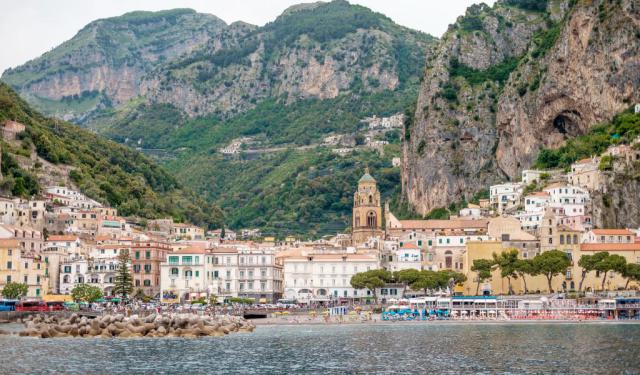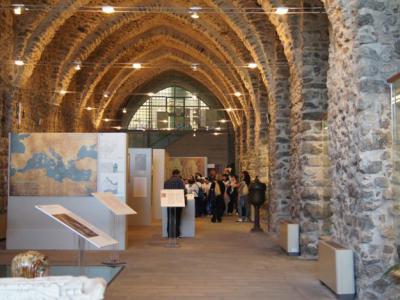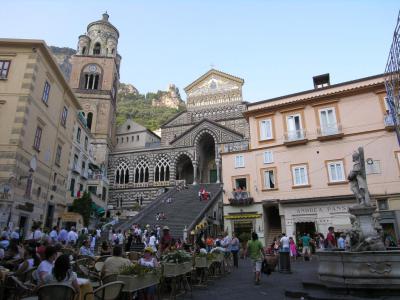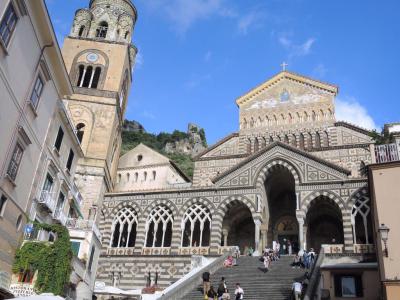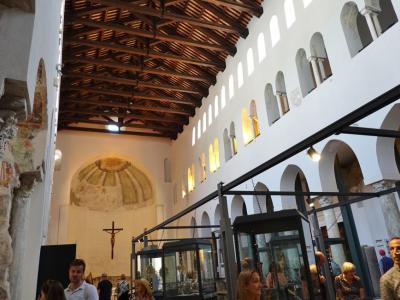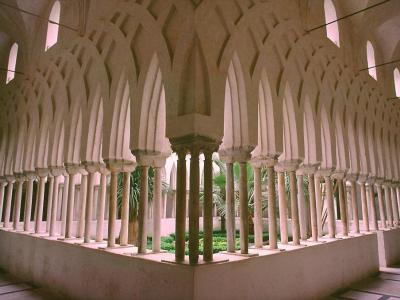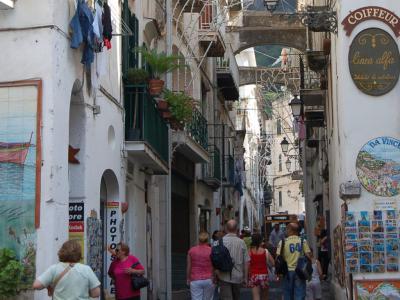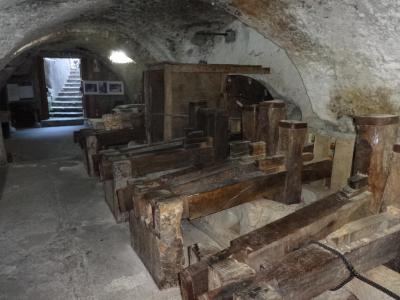Audio Guide: Amalfi Introduction Walking Tour (Self Guided), Amalfi
Whether legend or truth, Amalfi residents claim that 14th-century sailor Flavio Gioia invented the magnetic compass. Given the town’s maritime heritage, we might give them the benefit of the doubt.
Amalfi, often called the “Jewel of the Amalfi Coast,” carries a history that runs much deeper than the pastel houses and seaside charm visitors see today. The origin of the town’s name is disputed, with several conflicting claims. Whatever its source, the name has always been tied to the sea, which has shaped Amalfi’s destiny since its earliest days.
By the 4th and 5th centuries AD, Amalfi had already taken root as a thriving coastal community. Its natural harbor gave it an advantage, and by the 9th century, it had risen to join the ranks of the great maritime republics, alongside Venice, Pisa, and Genoa. Amalfi’s fleets carried goods across the seas, trading with North Africa, Byzantium, and the Levant. Its sailors gave Europe the Tabula Amalphitana, a maritime code that influenced sea law for centuries.
The wealth brought by trade also enriched the town culturally and spiritually. The Amalfi Cathedral, dedicated to Saint Andrew the Apostle, became both a place of pilgrimage and a declaration of the city’s prestige. The arrival of the saint’s relics in the 13th century deepened Amalfi’s role as a crossroads of devotion and commerce.
Amalfi’s golden age did not last. Arabic raids, internal conflicts, and the rise of rival maritime powers weakened it. In 1137, Pisa defeated Amalfi in battle, marking the beginning of its decline. Natural disasters-earthquakes, landslides, and even tsunamis-further reduced its power, and the once-mighty republic faded into a modest coastal town. Yet Amalfi adapted, sustaining itself through fishing, lemon cultivation, and papermaking.
In the 19th and 20th centuries, Amalfi found new life as a destination for travelers. By the 1920s and ’30s, it had become a favorite retreat of the British elite, celebrated for its beauty, food, and sea air.
The city's downtown draws visitors like a magnet, thanks to Cathedral Square, dominated by the grand steps and striped façade of the Amalfi Cathedral. Around it, narrow medieval alleys twist with shops selling ceramics and lemon sweets. A splash of maritime history lingers at the waterfront, where the old Arsenal of the Maritime Republic recalls Amalfi’s seafaring past.
For centuries, Amalfi pointed sailors across the seas, and today it points visitors inward-to its history and its beauty. Follow its direction, and you’ll find a town that has always known how to navigate both storm and calm.
Amalfi, often called the “Jewel of the Amalfi Coast,” carries a history that runs much deeper than the pastel houses and seaside charm visitors see today. The origin of the town’s name is disputed, with several conflicting claims. Whatever its source, the name has always been tied to the sea, which has shaped Amalfi’s destiny since its earliest days.
By the 4th and 5th centuries AD, Amalfi had already taken root as a thriving coastal community. Its natural harbor gave it an advantage, and by the 9th century, it had risen to join the ranks of the great maritime republics, alongside Venice, Pisa, and Genoa. Amalfi’s fleets carried goods across the seas, trading with North Africa, Byzantium, and the Levant. Its sailors gave Europe the Tabula Amalphitana, a maritime code that influenced sea law for centuries.
The wealth brought by trade also enriched the town culturally and spiritually. The Amalfi Cathedral, dedicated to Saint Andrew the Apostle, became both a place of pilgrimage and a declaration of the city’s prestige. The arrival of the saint’s relics in the 13th century deepened Amalfi’s role as a crossroads of devotion and commerce.
Amalfi’s golden age did not last. Arabic raids, internal conflicts, and the rise of rival maritime powers weakened it. In 1137, Pisa defeated Amalfi in battle, marking the beginning of its decline. Natural disasters-earthquakes, landslides, and even tsunamis-further reduced its power, and the once-mighty republic faded into a modest coastal town. Yet Amalfi adapted, sustaining itself through fishing, lemon cultivation, and papermaking.
In the 19th and 20th centuries, Amalfi found new life as a destination for travelers. By the 1920s and ’30s, it had become a favorite retreat of the British elite, celebrated for its beauty, food, and sea air.
The city's downtown draws visitors like a magnet, thanks to Cathedral Square, dominated by the grand steps and striped façade of the Amalfi Cathedral. Around it, narrow medieval alleys twist with shops selling ceramics and lemon sweets. A splash of maritime history lingers at the waterfront, where the old Arsenal of the Maritime Republic recalls Amalfi’s seafaring past.
For centuries, Amalfi pointed sailors across the seas, and today it points visitors inward-to its history and its beauty. Follow its direction, and you’ll find a town that has always known how to navigate both storm and calm.
How it works: Download the app "GPSmyCity: Walks in 1K+ Cities" from Apple App Store or Google Play Store to your mobile phone or tablet. The app turns your mobile device into a personal tour guide and its built-in GPS navigation functions guide you from one tour stop to next. The app works offline, so no data plan is needed when traveling abroad.
Amalfi Introduction Walking Tour Map
Guide Name: Amalfi Introduction Walking Tour
Guide Location: Italy » Amalfi (See other walking tours in Amalfi)
Guide Type: Self-guided Walking Tour (Sightseeing)
# of Attractions: 7
Tour Duration: 1 Hour(s)
Travel Distance: 0.9 Km or 0.6 Miles
Author: DanaOffice
Sight(s) Featured in This Guide:
Guide Location: Italy » Amalfi (See other walking tours in Amalfi)
Guide Type: Self-guided Walking Tour (Sightseeing)
# of Attractions: 7
Tour Duration: 1 Hour(s)
Travel Distance: 0.9 Km or 0.6 Miles
Author: DanaOffice
Sight(s) Featured in This Guide:
- Arsenal of the Maritime Republic
- Piazza del Duomo (Cathedral Square)
- Duomo di Sant'Andrea (Amalfi Cathedral)
- Diocesan Museum of Amalfi
- Chiostro del Paradiso (Cloister of Paradise)
- Via Lorenzo d'Amalfi (Lorenzo d'Amalfi Street)
- Museo della Carta (Museum of Handmade Paper)
1) Arsenal of the Maritime Republic
The Arsenal of the Maritime Republic in Amalfi carries the echoes of a time when this small coastal town was one of the Mediterranean’s great powers. Built in the 11th and 12th centuries, it served as the heart of Amalfi’s naval operations, where shipbuilders labored day and night to construct and repair the galleys that once ruled the seas. These vessels carried merchants and pilgrims across the waters, and sometimes warriors too, bound for distant shores from Byzantium to North Africa. It was here that the Tabula Amalphitana, Amalfi’s influential maritime code, was given life, guiding the laws of the sea for centuries to come.
Legend has it that in these very halls, sailors discussed innovations that would shape seafaring itself. Some Amalfitans even claim that Flavio Gioia, the 14th-century figure often credited with perfecting the magnetic compass, had ties to the city’s shipyards. True or not, the story fits naturally with a place so steeped in the rhythms of navigation and discovery.
Though only part of the arsenal survives—much of it lost to the sea over time—the remaining vaulted halls still stir the imagination. The clang of hammers, the scent of tar, and the urgency of preparation seem to linger in the stone, reminders of Amalfi’s golden age as a maritime republic. Today, the arsenal has been reborn as a cultural space. Since 2010, it has housed the Compass Museum, where visitors can explore the history of navigation and see ship models, artifacts, and even a row-barge used in Amalfi’s Historical Regatta.
Walking through its arches now, you do not just encounter exhibits—you step into the atmosphere of a city once carried on the tides, its legacy still alive in stone, sea, and story.
Legend has it that in these very halls, sailors discussed innovations that would shape seafaring itself. Some Amalfitans even claim that Flavio Gioia, the 14th-century figure often credited with perfecting the magnetic compass, had ties to the city’s shipyards. True or not, the story fits naturally with a place so steeped in the rhythms of navigation and discovery.
Though only part of the arsenal survives—much of it lost to the sea over time—the remaining vaulted halls still stir the imagination. The clang of hammers, the scent of tar, and the urgency of preparation seem to linger in the stone, reminders of Amalfi’s golden age as a maritime republic. Today, the arsenal has been reborn as a cultural space. Since 2010, it has housed the Compass Museum, where visitors can explore the history of navigation and see ship models, artifacts, and even a row-barge used in Amalfi’s Historical Regatta.
Walking through its arches now, you do not just encounter exhibits—you step into the atmosphere of a city once carried on the tides, its legacy still alive in stone, sea, and story.
2) Piazza del Duomo (Cathedral Square) (must see)
Cathedral Square in Amalfi may be small, but it has always carried a weight far greater than its size. For centuries, this open space has been the beating heart of the town, where daily life, devotion, and commerce intersect. Its most dramatic feature is the grand staircase leading to the Amalfi Cathedral, dedicated to Saint Andrew, whose relics were brought here in the 13th century. That moment transformed Amalfi into a pilgrimage destination, and pilgrims resting in the square before climbing the steps became a familiar sight through the ages.
Merchants once filled the square with stalls and chatter, trading goods carried from distant ports, while the cathedral bells rang out to mark time and call to prayer. Even when Amalfi’s power waned after its days as a maritime republic, the square never lost its role as a place where the community gathered in faith and celebration. Festivals, markets, and public announcements all unfolded here, with the cathedral’s striped façade rising as both a backdrop and a reminder of the town’s enduring spirit.
In 1869, the addition of the Sant’Andrea Fountain gave the square another focal point. Locals would pause here to fill their cups or share news by its cool waters, a tradition still mirrored today when visitors gather around to rest or refresh during their walks.
Now, Cathedral Square thrives with a blend of old and new. Cafés spill onto the cobbles, musicians play in the shade, and tourists sip limoncello while watching life pass by. The square remains a stage where history and the present mingle, a place where faith, commerce, and community still echo together. Standing here, you don’t just see Amalfi—you feel its pulse.
Merchants once filled the square with stalls and chatter, trading goods carried from distant ports, while the cathedral bells rang out to mark time and call to prayer. Even when Amalfi’s power waned after its days as a maritime republic, the square never lost its role as a place where the community gathered in faith and celebration. Festivals, markets, and public announcements all unfolded here, with the cathedral’s striped façade rising as both a backdrop and a reminder of the town’s enduring spirit.
In 1869, the addition of the Sant’Andrea Fountain gave the square another focal point. Locals would pause here to fill their cups or share news by its cool waters, a tradition still mirrored today when visitors gather around to rest or refresh during their walks.
Now, Cathedral Square thrives with a blend of old and new. Cafés spill onto the cobbles, musicians play in the shade, and tourists sip limoncello while watching life pass by. The square remains a stage where history and the present mingle, a place where faith, commerce, and community still echo together. Standing here, you don’t just see Amalfi—you feel its pulse.
3) Duomo di Sant'Andrea (Amalfi Cathedral) (must see)
Amalfi Cathedral, dedicated to Saint Andrew the Apostle, dominates the town’s Cathedral Square and tells a story that stretches back over a millennium. The first church on this site was built in the 9th century, when Amalfi was beginning to rise as a maritime power, its fleets trading across the Mediterranean. As the town grew in wealth and influence, the cathedral expanded and transformed, blending styles from different eras—Romanesque, Baroque, Arab-Norman—so that each addition marked a chapter in Amalfi’s changing fortunes.
A defining moment came in 1208, when Cardinal Peter of Capua brought the relics of Saint Andrew from Constantinople. Their arrival instantly elevated Amalfi into one of the great pilgrimage destinations of the Mediterranean. Legend says that a miraculous manna, a sweet liquid, began to flow from the bones of the saint, drawing pilgrims from across Europe. Imagine the scene centuries ago: sailors arriving at the harbor, climbing the grand staircase, and kneeling in the crypt, hoping for healing or blessings. Even today, visitors continue that ritual, gathering in quiet reverence before the relics that made Amalfi famous.
The cathedral was not only a spiritual heart but also a civic stage. Its bells once set the rhythm of daily life, calling people to prayer, announcing festivals, or marking emergencies. The square outside filled with markets, merchants, and ceremonies, while inside the cathedral frescoes, mosaics, and chapels reflected a blend of Byzantine, Norman, and Italian influences. Over time, disasters struck—like the partial collapse of its façade in 1861—but the cathedral always rose again, rebuilt and renewed, much like the town itself.
For travelers today, Amalfi Cathedral is less about technical details than about presence. Climbing its monumental staircase, standing in the cool interior, or pausing at the crypt of Saint Andrew, one senses both the weight of history and the resilience of faith. It remains a beacon, as it once was for sailors returning from sea, a symbol of continuity where devotion and community still meet under the striped façade.
A defining moment came in 1208, when Cardinal Peter of Capua brought the relics of Saint Andrew from Constantinople. Their arrival instantly elevated Amalfi into one of the great pilgrimage destinations of the Mediterranean. Legend says that a miraculous manna, a sweet liquid, began to flow from the bones of the saint, drawing pilgrims from across Europe. Imagine the scene centuries ago: sailors arriving at the harbor, climbing the grand staircase, and kneeling in the crypt, hoping for healing or blessings. Even today, visitors continue that ritual, gathering in quiet reverence before the relics that made Amalfi famous.
The cathedral was not only a spiritual heart but also a civic stage. Its bells once set the rhythm of daily life, calling people to prayer, announcing festivals, or marking emergencies. The square outside filled with markets, merchants, and ceremonies, while inside the cathedral frescoes, mosaics, and chapels reflected a blend of Byzantine, Norman, and Italian influences. Over time, disasters struck—like the partial collapse of its façade in 1861—but the cathedral always rose again, rebuilt and renewed, much like the town itself.
For travelers today, Amalfi Cathedral is less about technical details than about presence. Climbing its monumental staircase, standing in the cool interior, or pausing at the crypt of Saint Andrew, one senses both the weight of history and the resilience of faith. It remains a beacon, as it once was for sailors returning from sea, a symbol of continuity where devotion and community still meet under the striped façade.
4) Diocesan Museum of Amalfi
The Diocesan Museum of Amalfi is more than just a museum—it is a journey through the layers of the town’s faith and history, all housed within the ancient Basilica of the Crucifix. Built in the 9th century, the basilica was once one of Amalfi’s earliest Christian gathering places. Locals still tell how generations of families once came here to pray, before the church gradually transformed into the museum that preserves the town’s treasures today. Walking through its quiet halls, you can almost imagine the voices of medieval worshippers blending with the hum of artisans preparing relics and vestments for great feast days.
The museum was officially founded in 1996 to protect centuries of accumulated sacred objects belonging to the Archdiocese. Its collection includes silverware, vestments, processional crosses, illuminated manuscripts, and reliquaries—objects that not only served ritual purposes but also reflect Amalfi’s position as a crossroads of cultures. The influence of Byzantines, Normans, and Italians is evident in the details, reminding visitors that this coastal town once carried great weight across the Mediterranean. One of the most evocative pieces is a richly embroidered altar frontal, said to have been created by local craftsmen at a time when Amalfi rivaled Venice and Pisa in power.
Equally fascinating are the remnants of the basilica itself: fragments of frescoes, stone columns, and inscriptions that survived centuries of change. The building has been rebuilt and restored many times, but the museum deliberately reveals these older layers, allowing the past to remain visible.
For visitors, the Diocesan Museum offers not only beautiful artifacts but also the sense of entering into Amalfi’s long spiritual rhythm. It is a place where devotion and artistry met, and where history continues to whisper through stone and silver alike.
The museum was officially founded in 1996 to protect centuries of accumulated sacred objects belonging to the Archdiocese. Its collection includes silverware, vestments, processional crosses, illuminated manuscripts, and reliquaries—objects that not only served ritual purposes but also reflect Amalfi’s position as a crossroads of cultures. The influence of Byzantines, Normans, and Italians is evident in the details, reminding visitors that this coastal town once carried great weight across the Mediterranean. One of the most evocative pieces is a richly embroidered altar frontal, said to have been created by local craftsmen at a time when Amalfi rivaled Venice and Pisa in power.
Equally fascinating are the remnants of the basilica itself: fragments of frescoes, stone columns, and inscriptions that survived centuries of change. The building has been rebuilt and restored many times, but the museum deliberately reveals these older layers, allowing the past to remain visible.
For visitors, the Diocesan Museum offers not only beautiful artifacts but also the sense of entering into Amalfi’s long spiritual rhythm. It is a place where devotion and artistry met, and where history continues to whisper through stone and silver alike.
5) Chiostro del Paradiso (Cloister of Paradise)
The Cloister of Paradise in Amalfi is a serene and poignant corner of the cathedral complex, built between 1266 and 1268 under Archbishop Filippo Augustariccio to serve as the burial ground for the town’s noble families. What feels like poetry in stone was born from a more practical purpose—honoring the dead with dignity, close to the spiritual heart of Amalfi.
Walking through its cool arches, one encounters 120 marble columns that support rows of Arabic-influenced arches, creating an ambience of quiet grace. Palm trees rise among the walkways, casting shifting shadows on the paving below, and fragments of 13th-century frescoes still peek from the walls, offering glimpses into the cloister’s sacred past.
One touchingly specific detail: along the northern side you can catch a perfectly framed glimpse of the Duomo’s campanile through one of the arches, as though the cloister itself is winking at its neighbor. Below the cloisters, a crypt connects toward the relics of Saint Andrew preserved in the cathedral, deepening the sense that this is not just architectural decoration, but part of Amalfi’s living spiritual pulse.
Over time, the cloister ceased its function as a cemetery and instead became a passage linking the cathedral to the Diocesan Museum. Today it invites visitors to pause between the hum of the square and the grand steps to the cathedral. In that silence, under arches weathered by centuries, one can sense how Amalfi has always carried its layers of faith, memory, and cross-cultural exchange.
For travelers, the Cloister of Paradise isn’t merely a detour—it’s a quiet center where centuries converge, where stone and shadow whisper the town’s deeper story.
Walking through its cool arches, one encounters 120 marble columns that support rows of Arabic-influenced arches, creating an ambience of quiet grace. Palm trees rise among the walkways, casting shifting shadows on the paving below, and fragments of 13th-century frescoes still peek from the walls, offering glimpses into the cloister’s sacred past.
One touchingly specific detail: along the northern side you can catch a perfectly framed glimpse of the Duomo’s campanile through one of the arches, as though the cloister itself is winking at its neighbor. Below the cloisters, a crypt connects toward the relics of Saint Andrew preserved in the cathedral, deepening the sense that this is not just architectural decoration, but part of Amalfi’s living spiritual pulse.
Over time, the cloister ceased its function as a cemetery and instead became a passage linking the cathedral to the Diocesan Museum. Today it invites visitors to pause between the hum of the square and the grand steps to the cathedral. In that silence, under arches weathered by centuries, one can sense how Amalfi has always carried its layers of faith, memory, and cross-cultural exchange.
For travelers, the Cloister of Paradise isn’t merely a detour—it’s a quiet center where centuries converge, where stone and shadow whisper the town’s deeper story.
6) Via Lorenzo d'Amalfi (Lorenzo d'Amalfi Street)
Lorenzo d’Amalfi Street is more than just the main road through Amalfi—it is the lifeline of the town, a place where history, faith, and daily life have intertwined for centuries. Beginning near the waterfront and winding up toward Cathedral Square, the street follows the valley that naturally shaped Amalfi’s growth. Once used by merchants to haul silks, spices, and paper from the port, it became the town’s busiest thoroughfare, alive with voices bargaining and bells ringing overhead.
The name recalls Saint Lorenzo, closely tied to Amalfi’s religious traditions, but the spirit of the street has always been rooted in trade and hospitality. In medieval times, visiting merchants from the East would often stop here, not only to exchange goods but to marvel at the lively stalls packed into the narrow gorge. Local lore tells of pilgrims en route to Saint Andrew’s relics who would pause for refreshment along this very road, mingling with traders and sailors in a scene that captured Amalfi’s dual role as both marketplace and pilgrimage stop.
Today, much of that energy remains. Shopkeepers display brightly painted ceramics, handmade sandals, and lemon-themed scarves, while the scent of pastries drifts from bakeries selling sfogliatella and lemon desserts. For many visitors, the highlight is not simply the shopping but the rhythm of the street itself—children darting between tables, neighbors chatting across balconies, and tourists pausing for coffee or limoncello before climbing the cathedral’s grand staircase.
To walk along Lorenzo d’Amalfi Street is to experience Amalfi’s character in motion: a place where faith and commerce, legend and daily life, still meet in one vibrant artery.
The name recalls Saint Lorenzo, closely tied to Amalfi’s religious traditions, but the spirit of the street has always been rooted in trade and hospitality. In medieval times, visiting merchants from the East would often stop here, not only to exchange goods but to marvel at the lively stalls packed into the narrow gorge. Local lore tells of pilgrims en route to Saint Andrew’s relics who would pause for refreshment along this very road, mingling with traders and sailors in a scene that captured Amalfi’s dual role as both marketplace and pilgrimage stop.
Today, much of that energy remains. Shopkeepers display brightly painted ceramics, handmade sandals, and lemon-themed scarves, while the scent of pastries drifts from bakeries selling sfogliatella and lemon desserts. For many visitors, the highlight is not simply the shopping but the rhythm of the street itself—children darting between tables, neighbors chatting across balconies, and tourists pausing for coffee or limoncello before climbing the cathedral’s grand staircase.
To walk along Lorenzo d’Amalfi Street is to experience Amalfi’s character in motion: a place where faith and commerce, legend and daily life, still meet in one vibrant artery.
7) Museo della Carta (Museum of Handmade Paper) (must see)
The Museum of Handmade Paper in Amalfi is more than a collection of old tools—it is a living memory of one of the town’s most prized traditions. Set in the Valley of the Mills, where streams once powered wooden hammers and presses, the museum occupies a 13th-century paper mill that still holds the scent of fiber and ink. Paper-making arrived here in the Middle Ages, most likely through Amalfi’s contact with Arab traders, and soon became one of the republic’s strongest industries. By the 12th century, Amalfi paper was sought after across the Mediterranean, known for its durability and favored in merchant contracts, legal records, and correspondence.
The building itself once belonged to the Milano family, one of Amalfi’s most prominent names in paper production. In 1969, it was Nicholas Milano who transformed his family’s old mill into a museum, preserving both the machinery and the memory of the craft. Walking through its halls, visitors can still hear the rhythm of mallets striking pulp, once the heartbeat of an industry that kept Amalfi in competition with other great maritime republics. One fact illustrates its prestige well: notaries in southern Italy often required contracts to be written on Amalfi paper, believing it to be sturdier than parchment—a small but telling detail of the town’s reputation.
Inside, guides demonstrate the traditional process step by step: linen rags softened in water, beaten into pulp, lifted in wooden frames, and pressed into thin sheets left to dry in the coastal air. Visitors can even try their hand at shaping a page, taking home a tangible reminder of this ancient craft. Exhibits of historic documents, intricate watermarks, and centuries-old sheets bring the story full circle, showing how Amalfi’s name once traveled the seas not only on ships, but on paper that carried trade, law, and ideas. For travelers, the museum offers a rare chance to stand in the very place where history was written—literally—sheet by sheet.
The building itself once belonged to the Milano family, one of Amalfi’s most prominent names in paper production. In 1969, it was Nicholas Milano who transformed his family’s old mill into a museum, preserving both the machinery and the memory of the craft. Walking through its halls, visitors can still hear the rhythm of mallets striking pulp, once the heartbeat of an industry that kept Amalfi in competition with other great maritime republics. One fact illustrates its prestige well: notaries in southern Italy often required contracts to be written on Amalfi paper, believing it to be sturdier than parchment—a small but telling detail of the town’s reputation.
Inside, guides demonstrate the traditional process step by step: linen rags softened in water, beaten into pulp, lifted in wooden frames, and pressed into thin sheets left to dry in the coastal air. Visitors can even try their hand at shaping a page, taking home a tangible reminder of this ancient craft. Exhibits of historic documents, intricate watermarks, and centuries-old sheets bring the story full circle, showing how Amalfi’s name once traveled the seas not only on ships, but on paper that carried trade, law, and ideas. For travelers, the museum offers a rare chance to stand in the very place where history was written—literally—sheet by sheet.
The Most Popular Cities
/ view all
